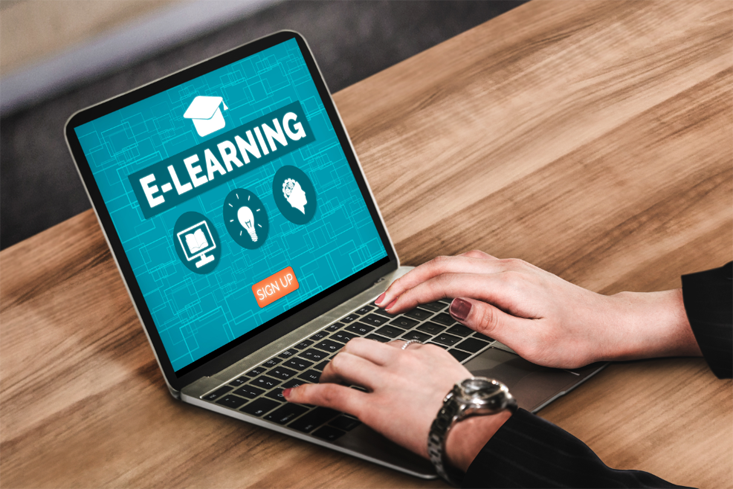6 Things You Need to Know About the Future of E-Learning

19 Jun 2020
6 Things You Need to Know About the Future of E-Learning
Alvin Toffler famously said that “The illiterate of the 21st century will not be those who cannot read and write, but those who cannot learn, unlearn, and relearn.” This quote aptly sums up the need to continuously upskill ourselves beyond the walls of education institutions to stay competent and competitive. Learning and development space has already been transforming at a rapid pace fueled by technology and innovation, and the Covid-19 pandemic will transform the magnitude of change to an unprecedented level.
As Work from Home (WFH) and Learn from Home (LFH) have become the new norm after this Covid-19 pandemic, educational institutions and organizations are bound to invest and commit more to E-learning and development. We know that the whole world of E-learning has jumped a few steps forward. We know that the number of digital courses available online has increased significantly. Nearly all universities have for instance gone digital. With amplified promise of better dividends of E-learning, here are the 6 things you need to know about the future of E-learning.
- Personalized Learning
- Social Learning
- Artificial Intelligence
- Gamification
- Mobile Learning
- Augmented & Virtual Reality
Personalized Learning
It’s about time we move beyond the concept of one content fits all at our education institutions and focus on personalized learning paths for students based upon interest and cognitive ability. Now, there’s a significant shift to personalized learning paths that allow everyone to learn at their own pace and interest. Thank advancements in technology, sophisticated algorithms, AI and Machine Learning which have helped carved personalized learning paths instead of arbitrary determination by academicians.It is fair to say that the personalized learning phase has just kickstarted and is going through its experimentation phase but there’s no reason that the trend won’t continue to uptick in the foreseeable future to create worthwhile personalized learning outcomes.

Social Learning
Learning won’t be restricted to conventional class rooms and academic institutions anymore and has become an ongoing phenomenon. Moving forward into the future, social learning will take place on social platforms at an unprecedented level in the hyperconnected world across social media channels. MOOCs, online forums, learning chatrooms, file-sharing platforms augment social learning and collaboration with more productive, efficient, and seamless manner. Social learning platforms would continue to develop, more and more collaborative tools for improved learning outcomes. What’s more is that, outside of individual classrooms and group project scenarios, social learning as a whole could grow to become the spine of school-wide curriculums everywhere.

Artificial Intelligence
It’s about time we move beyond the concept of one content fits all at our education institutions and focus on personalized learning paths for students based upon interest and cognitive ability. Now, there’s a significant shift to personalized learning paths that allow everyone to learn at their own pace and interest. Thank advancements in technology, sophisticated algorithms, AI and Machine Learning which have helped carved personalized learning paths instead of arbitrary determination by academicians.It is fair to say that the personalized learning phase has just kickstarted and is going through its experimentation phase but there’s no reason that the trend won’t continue to uptick in the foreseeable future to create worthwhile personalized learning outcomes.

Gamification
Learning is always easy, irrespective of age and subject, when it’s more of a fun than a boring lesson. Game based learning mainly referred as gamification is an aspect of E-Learning that is making the future of learning more engaging, interesting and fun. Gamification would hugely impact the way we learn, engage, and retain knowledge.Keeping in mind the impact of gamification on E-Learning, game-based learning spaces will continue to expand to transform learning experiences inside physical and virtual classrooms. With increasing personalized nature of learning, learning through gamification would take the center stage and fill the gap in this space in the future.Given the large swath of positive results, there’s no reason that game-based learning solutions will not continue to be implemented in classrooms, both digital and physical, for the foreseeable future. Moreover, when it comes to the somewhat impersonal nature of E-Learning in particular, gamification of the industry is not just welcomed, it’s ideal.

Mobile Learning
With the penetration of mobile technology in our lives at an extraordinary level, we can literally do anything with our mobile that was unthinkable 2 decades ago. But it is fair to say that mobile learning (M-Learning) has not really picked up to compete with other E-Learning applications, despite the fact that a huge amount of additional capabilities has been added to mobile devices. Having said that, for the future, there’s no doubt that M-Learning will continue grow.The trend started with learning apps designed for children that would help them learn languages and pick up math skills with ease. As people observed the high success rates and benefits of these mobile apps, it was all but inevitable that companies will put more efforts to tap into the world of apps to cater to adult learning and skill development. With agile business philosophy being the order of the day and the ease with which mobile apps can be built, probably in the next few years, we will witness the trend of ‘mobile-only’ learning apps for the modern workforce.

Augmented & Virtual Reality
In 2022, the Augmented and Virtual Reality market is expected to reach a market size of 209.2 billion U.S. dollars. Augmented & Virtual Reality in education has already become a $200 million industry in 2020 and $700 million by 2025. Augmented and Virtual Reality solutions are seeing such an exponential growth as they are becoming less expensive and more accessible to the general public.AR/VR would enable teachers to simulate experiences that are relevant to the material covered in class for higher engagement and better retention of the content. There would be endless opportunities for integrating AR and VR in E-Learning. From creating designs that transport the learner to the insides of automobiles and locomotives to helping medical students understand the intricacies of the human body, AR and VR will have a massive role to play in making E-Learning more interesting and engaging for modern learners. These solutions offer an immersive learning experience and help learners get realistic learning experiences.










